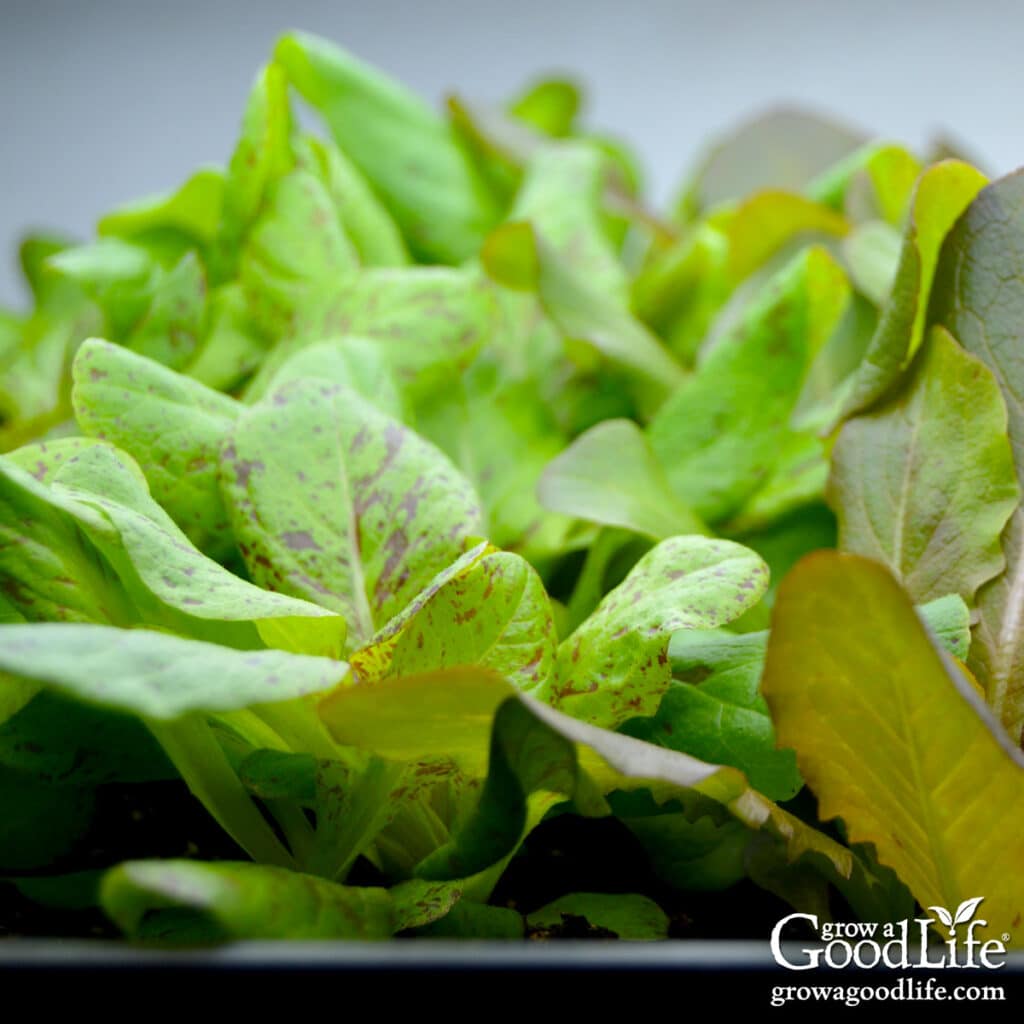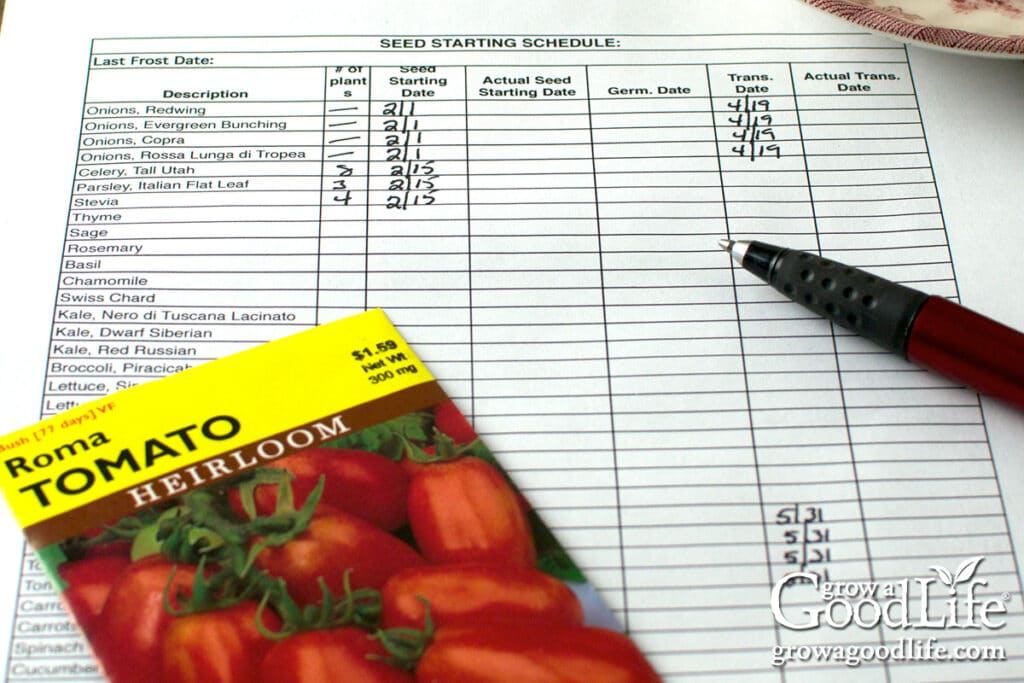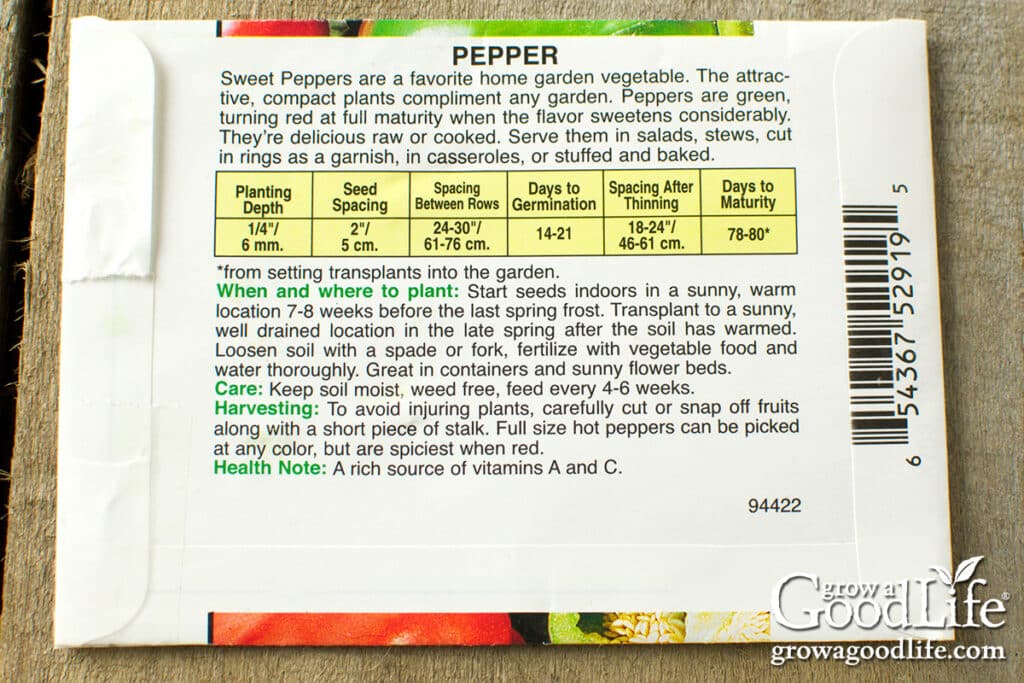How to Create a Seed Starting Schedule for Your Vegetable Garden
This post may contain affiliate links, which means that I may receive a commission if you make a purchase using these links. As an Amazon Associate I earn from qualifying purchases.
Learn exactly when to start seeds indoors and when to direct sow outside by creating a seed starting schedule tailored to your frost date and garden plan.

Starting seeds indoors is one of my favorite gardening rituals. After months of cold, dark days, it feels so good to hover over warm trays of soil, waiting for tiny green shoots to emerge. Growing your own transplants is also far more economical than buying nursery plants, and it opens the door to unique varieties you’ll never find in a store.
By the time you reach this step, you’ve likely already chosen the vegetables you want to grow, organized your seed collection, and mapped out your garden beds so you know how many plants you need to start. If not, take a moment to review the earlier posts in this series:
- How to Choose Vegetables for Your Garden
- Tips for Buying Seeds for Your Vegetable Garden
- How to Plan and Map Your Vegetable Garden Beds
Now it’s time to answer the big question every gardener faces:
When should I start my seeds?
Start too early and you’ll end up with leggy seedlings. Start too late and your plants may not have enough time to mature and produce before the fall frost. The solution is simple: create a seed starting and planting schedule tailored to your frost dates and your chosen crops. Let me walk you through it.
Why a Seed Starting Schedule Matters
A good schedule takes the guesswork out of spring. Instead of wondering each week what you should be sowing, you’ll have a clear plan that tells you:
- Which seeds to start indoors and when.
- Which crops should be direct-sown outdoors.
- When seedlings should be hardened off and transplanted.
- How many plants you need to start for each bed.
It also helps prevent the two most common beginner mistakes:
- Starting seeds too early (plants get tall, weak, and stressed).
- Starting seeds too late (slower crops like peppers and onions fall behind).
Every year becomes easier. Once you create your seed planting calendar the first time, you can reuse it and adjust based on the notes you take in your garden journal.
How to Make a Seed Starting Schedule (Step by Step)
A seed starting schedule may sound complicated, but it’s really just a simple timeline built around your estimated spring frost-free date and the needs of each crop. If this is your first year creating one, don’t worry. It mostly comes down to counting backwards from that frost date and noting when each crop should be started.
Once you make your schedule the first time, you can reuse and refine it every season. These steps walk you through my exact process, the same one I still use today to keep my seed starting organized and stress-free.
Step 1: Find Your Last Expected Frost Date
Your last frost date is the backbone of your seed-starting timeline. Every “start X weeks before frost” instruction counts backward from this date.
You can estimate your frost date by:
- Asking local gardeners or your nursery
- Checking with your Cooperative Extension
- Entering your ZIP code into PlantMaps.com
Don’t worry if different sources vary by a few days. Frost dates are a guideline, not a guarantee. Choose a reasonable average and use it consistently.

Step 2: Set Up Your Seed Starting Chart
A simple spreadsheet works wonderfully, but a printed worksheet or garden journal page is just as effective.
Create columns for:
- Crop name
- Number of plants needed
- Indoor sowing date
- Actual sowing date
- Germination date
- Transplant date
- Actual transplant date

Step 3: Look Up Each Crop’s Recommended Timing
The back of the seed package provides instructions on when to sow your seeds indoors and when to transplant the seedlings into the vegetable garden. Turn over each seed packet and look for phrases like:
- “Start indoors 6–8 weeks before last frost”
- “Direct sow after danger of frost”
- “Transplant outdoors when soil has warmed”
Use these guidelines to calculate your specific dates for each crop.
Example: Peppers
For example, the pepper seed package below says to “start seeds indoors 7-8 weeks before the last spring frost.” The seed package also tells us when to transplant the seedlings, “…in the late spring after the soil has warmed.”

So, if your frost date is May 20:
- Packet says: “Start indoors 7–8 weeks before frost.”
- 7-8 weeks back = March 25–April 1.
Your pepper schedule becomes:
- Start seeds: Around March 25–April 1.
- Transplant outdoors: About a week after frost. Harden off your seedlings and aim to transplant around May 27.
Repeat this process for every crop on your list. Sort the seed packages into groups based on the number of weeks to sow before your estimated last frost date.
Below is a general guideline:
- 10 to 12 weeks: Celery, celeriac, eggplant, green onions and scallions, leeks, onions, rosemary, and thyme.
- 8 to 10 weeks: Artichokes, chives, endive, parsley, and peppers.
- 6 to 8 weeks: Basil, chamomile, kale, lemon balm, marjoram, mint, oregano, sage, and tomatoes.
- 4 to 6 weeks: Broccoli, Brussels sprouts, cabbage, cantaloupe, cauliflower, collards, kohlrabi, spinach, and Swiss chard.
- 4 weeks: Cucumbers, dill, lettuce, melons, pumpkins, summer squash, watermelons, winter squash, and zucchini.
Direct sow guidelines:
Some crops don’t need to be started early indoors under lights and can be directly sowed into the vegetable garden. See 13 Easy Vegetables to Direct Sow for more information.
- Cool-season crops (spring and again mid-summer for fall): Beets, carrots, chard, kale, lettuce, parsnips, peas, radishes, spinach, and turnips.
- Warm-season crops (sow after all danger of frost has passed): Beans, cilantro, corn, cucumbers, summer squash, and winter squash.
Step 4: Add Dates to Your Schedule
Record all your sowing and transplanting dates in your chart. Round dates to the nearest Sunday so each week feels organized and easy to manage.
In your spreadsheet, fill in the name of the crop in the description column, the number of seedlings you will need based on your vegetable garden map, the date to sow the seeds, and the date to transplant the seedlings into the garden.
As you fill in your transplant dates, be sure to include hardening-off time. Most seedlings need about a week outdoors in increasing light before planting. See my guide: How to Harden Off Seedlings Before Planting.
When you step back and look at the full schedule, you’ll begin to notice a few clear patterns:
- Slow growers get started first: Peppers, onions, leeks, celery, and other long-season crops need the earliest indoor start.
- Most crops fall in the middle: Tomatoes, brassicas (like broccoli and cabbage), and many herbs are started about 6 to 8 weeks before frost.
- Fast growers wait until later: Cucumbers, squash, melons, and lettuces only need about 3 to 4 weeks indoors, if they’re started inside at all.
- Some seeds go straight into the garden: Many leafy greens, root vegetables, peas, beans, and corn prefer to be direct-sown outdoors.
Seeing these patterns makes the whole process feel more intuitive, and it becomes much easier to plan your seed-starting week by week.
Step 5: Keep Notes for Next Year
You will notice that I have a column in my spreadsheet where I can record when the seed germinated and the real dates of when the seed was sown and transplanted into the garden. That way I can see whether I need to make changes next year.
One adjustment I made in my second year was the seed starting date for peppers. The first year I grew peppers in my unheated basement, they grew slowly because the space was cool. The following year, I added two extra weeks under the lights, and it made all the difference. More tips: How to Keep a Gardening Journal.
Once seedlings are growing, jot down:
- When they germinated
- How quickly they grew under your lights
- Whether they were too small or too big at transplant time
This is how your schedule improves year after year.

Common Mistakes When Creating a Seed Starting Schedule
Avoiding these pitfalls will help your seedlings grow strong and your spring transplanting go smoothly.
Starting seeds too early: It’s tempting to jump in as soon as the seed catalogs arrive, but early isn’t better. Plants started too soon often become leggy, rootbound, or stressed before the garden is ready. Stick to the timeline based on your frost date.
Forgetting to check your frost dates: Your entire schedule depends on this number. Frost dates vary from town to town, and even between neighborhoods. Double-check yours each year, especially if you’ve recently moved or garden in a microclimate.
Underestimating how much light seedlings need: Most vegetable seedlings require 12 to 16 hours of bright, direct light. A sunny window usually isn’t enough. Insufficient light leads to weak, stretched seedlings that struggle outdoors.
Starting warm-weather crops in a cold room: Peppers, eggplant, basil, and tomatoes dislike chilly soil. If your seed-starting area is cool or in a basement, these crops may lag behind. Use a seedling heat mat or place warm-season crops in your warmest location.
Not keeping notes from year to year: Your first schedule will get you started, but your notes make it better every season. Tracking actual sowing dates, germination times, and transplant results will help you fine-tune next year’s timeline.
Forgetting to factor in hardening-off time: Seedlings can’t go from a warm indoor setup to full sun outdoors without an adjustment period. Allow 7 to 10 days for hardening off so your plants are ready to handle wind, sun, and fluctuating temperatures.
Overcrowding your seed trays: Cramming too many seeds in one cell leads to root competition and weak starts. Thin early or sow more sparingly in the beginning.
Not adjusting for slow growers or faster-than-expected crops: Some varieties sprout earlier or later than the seed packet suggests. If something germinates in half the time or needs two extra weeks under lights, make a note so next year’s schedule matches reality.
A Thoughtful Schedule Makes Spring Feel Easy
Once your seed starting schedule is in place, the rest of spring gardening feels far more manageable. No more guessing or rushing. Each week has a clear task, and by the time warm weather arrives, you’ll have strong, healthy seedlings ready to move outdoors.
Creating this plan is one of my favorite winter rituals. I pour a cup of tea, spread my seed packets across the table, and dream about the season ahead while snow still covers the ground. Soon enough, those plans turn into real seedlings, warm soil, and delicious harvests.
Related Articles in the Planning Your Vegetable Garden Series:
- Using Grow Lights for Seedlings and Indoor Gardens
- How to Choose Vegetables for Your Garden
- Tips for Buying Seeds for Your Vegetable Garden
- How to Plan and Map Your Vegetable Garden Beds
- How to Start Seeds Indoors
This post was originally published February 10, 2015. It has been updated with more information and details to help you make a seed starting schedule for your vegetable garden.
Good planning is key to a successful vegetable garden
Whether you are new to growing your own food or have been growing a vegetable garden for years, you will benefit from some planning each year. You will find everything you need to organize and plan your vegetable garden in my PDF eBook, Grow a Good Life Guide to Planning Your Vegetable Garden.


Thank you for this clear and concise article on when to start seeds indoors. To me the packet information can be confusing from one company to the next so it was really helpful to see the recommended seed starting time
I wondered if you might offer some guidance on when to start seeds in soil blocks. I have heard they grow quickly and you need to adjust timing to a shorter window. Do you recommend using the seed packet directions and adjusting down by a certain amount of weeks or percentage and if so does that adjustment vary from plant to plant?
Thanks for any advice you can offer!
Gail, I have used soil blocks for over 20 years and do not find that they grow any quicker or slower than starting seedlings in trays. Just keep it simple. There is no need to adjust the timing if you are using soil blocks.
I know I’m late to this post, but I just want to say, “THANK YOU!” I have heard some of this information in several different places, but the clarity with which you describe the sowing/planting dates and that chart have finally helped me “get it.” I really appreciate this post!
Kristi, I am so happy to hear this post helped you with your seed starting schedule.
I am so behind in leeks and onions. I love the napkin idea but was wondering how carrots germinate if they are light dependent, Do you not cover the entire napkin with soil?
I am behind in starting onions this year too. I just sowed them yesterday. Hopefully, using a heat mat will jump start them a bit. Carrots are not light dependent. It is recommended that they be sowed 1/4- 1/2 inches deep. Just cover the seed mats with 1/4- to 1/2 inch soil and keep moist.
And here we are in Montana…today was 66 degrees! Weird and completely unseasonable! I’m so anxious to get things going in the garden but we all know Mother Nature has a wicked sense of humor!!
We are supposed to reach the 50s today, but another snowstorm is predicted for this weekend. I think Mother Nature is teasing us.:)
I can’t imagine when we’re going to be able to plant this year. More than 4′ of snow down, and more expected. It’ll take until July for this to melt.
I agree with you, Marie. We have about 3 feet covering the garden and not much is melting because it has been so cold.
Hi Rachel! I saw this earlier in the week and it’s a great reminder that I need to get started. There is nothing quite like fresh vegetables and fruits from your own garden. Thank you for linking up and sharing this at the Let’s Get Real Link Party last week. You can one of my featured articles this week. Stop by and grab our blog button.
I see that you start your seedlings in an unheated basement in Maine. I also have an unheated basement, and the temperature right now is around 50 down there. I’m going to have six grow lights given to me and so I was thinking of starting some seedlings but I wasn’t sure if that was warm enough ambient temperature to start them. Is there a minimum temperature that it needs to be with grow lights?
Hi Lori, My basement is unheated as well. Spring greens and cole crops will do fine growing in cooler temperatures. In fact, I find that the cooler temperatures make for a heartier transplant. Heat lovers, like tomatoes and peppers like it a little warmer but I won’t start those until later when the temperatures warm. I do often use a seedling heat mat to add heat so the seeds germinate quicker, but once they sprout they are removed from the heat mat and placed under lights. If you don’t have a heat mat, just placing your tray in a warm location will speed up germination.
Love this idea!! I’m planning a post on getting ready for a spring garden and would love to backlink to your post, if that’s ok?
Hi Helen, Yes, you can link to this post. I hear you are having some nice weather in your area. I be you can’t wait to garden.
This is great. I’ve recently been in almost panic mode just thinking about it. My seeds are ordered but haven’t even arrived yet:) We don’t even start them indoors until April.
Happy green thumbs.
I’m pushing back my seed starting this year because of all the snow we’re getting. 5 feet outside and more on the way. I can’t imagine being able to plant anything out anytime soon. I like the physical chart that you’ve set up. I’m not the most computer savvy person so I think I can handle that.